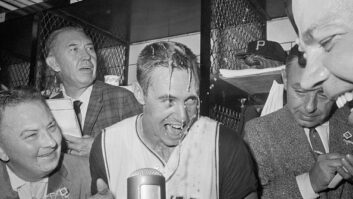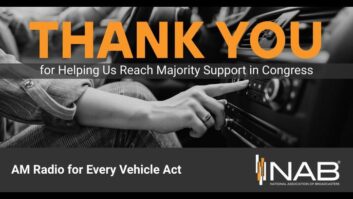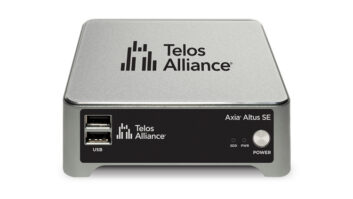Ed. Note: For an update and additional information on this story also see Nielsen 3-Minute Change Boosted Spring Results from July 27.
Nielsen’s recent notable tweak to its radio audience measurement process has brought significant changes to the ratings landscape in many major U.S. radio markets. The early returns show promise for broadcasters, though industry experts say it’s too early to make final determinations.
Since late last year, radio stations in the 48 markets where the Portable People Meter is used now receive full credit from Nielsen after just three minutes of listening per quarter hour instead of five. Diary-based markets still use five minutes as a standard.
The new measuring stick is still novel, but experts say several trends and key findings can be identified.
More short listening sessions are being credited following the changes, Nielsen says. But as one radio analyst put it: “Radio isn’t growing. Nielsen just changed the rules. And stations will take it.”
Mileage may vary
Rich Tunkel, managing director at Nielsen Audio, said the company expected that every station would have more reported audience with the move to the three-minute qualifier, but that results have varied based on the market and stations involved.

“For individual stations, the gains in audience are coming from higher daily cume audiences, which is what drives higher AQH,” he said.
“The playbook to grow audience hasn’t changed: Grow your daily cume. The way to do that is to entice new listeners every day and give reasons for existing listeners to show up more consistently.”
Tunkel says one misconception broadcasters have is that every radio segment now needs to be shorter and that stations need to change up their content into three-minute chunks.
“That is not the takeaway you want to get from this change. When Nielsen examined the radio listening behavior that led us to modify the qualifier, we saw that about half of radio occasions are shorter than five minutes and the majority of those short segments are three minutes long. But it doesn’t mean radio programming needs to be anchored to that.”
Instead, Tunkel says it just means broadcasters should be aware that listeners are constantly coming in and out of listening, so stations should be consistent in delivering the content.
“You don’t have much time to impress the audience before they leave. You may want to reset the segment and welcome new listeners more frequently, but some of the most compelling radio lasts as long as it needs, and that can be far longer than three minutes. Broadcasters shouldn’t get too narrowly focused on our qualifier rules when it comes to delivering compelling content.”
However, Tunkel says shorter durations of content might make it easier for those “snippets” to be reposted, placed on social media and released by broadcasters as highlights on digital platforms.
Another trend is the higher impression levels that radio is delivering in advertising campaigns. In other words, the media plans put in place by advertisers six or 12 months ago are now overachieving.
“We are seeing that campaigns bought off of the old data are delivering at higher total audience levels, which means fewer shortfalls and fewer makegoods,” he told Radio World.
“That is a trend that will likely only exist in 2025 and until campaign targets are reset. But higher impression levels for advertisers will persist for some time, showing the contribution of more listening in their market mix models.”
Early results
Broadcasters clearly are eager to start digging into the latest Nielsen ratings data reflecting the change.
Pierre Bouvard, chief insights officer for Cumulus Media/Westwood One, said this “enhanced” crediting solution has generated audience growth for the Cumulus stations across all demographics, ethnic groups, dayparts and programming formats.
[Related: “Nielsen: Radio Still Top U.S. Audio Platform”]
“This is truly a case of the rising tide raises all boats,” Bouvard said.
The most surprising finding for Bouvard has been the wide differences in growth by market. “Some of that might have to do with unique listening shifts or local events that occurred in some of the local markets,” he said.
Cumulus also has found a “positive response” to the shift from advertising agencies.
“In a world where digital ads are considered viewable with two seconds of exposure, shifting radio credit-listening from five minutes to three minutes is seen as a logical move. Media planners expect this shift will cause radio’s audience delivery to become even stronger than that of television.”
Bouvard said ad agencies have been excited to see that radio ad campaigns now generate greater reach and frequency.
However, he said many larger national advertisers are waiting for Nielsen’s spring 2025 book, to be published this summer, to see how it reflects the impact of the three-minute enhanced edit rule.
Joel Raab, a country radio programming consultant who works with Beasley and Bonneville, says the change in quarter hour accreditation shows promise, but it might be too early to determine how much it will deliver.
“It’s hard to draw any hard conclusions, but anecdotally, we have seen cume climb in certain formats like country and CHR. At the same time, time spent listening appears to have dropped a bit,” Raab said.
Raab says he has heard about some broadcasters shifting stopsets a bit deeper into the quarter hours to take advantage of the ratings shift.
Despite the rule change, Raab says some of the smaller PPM markets are “very susceptible to waffles in the ratings. The change in methodology in how they collect that data really doesn’t change that fact.”
Pubcasting benefits
There might be another format winner as a result of the change in listening measurement.
Longtime radio industry blogger Jerry Del Colliano says public broadcasters are benefitting from the change.
[Related: “What’s Next for Public Radio?”]
“Shorter listening sessions now get counted, and NPR benefits, especially among news-focused and drive-time listeners,” Del Colliano wrote on his Inside Music Media blog. “Those airing NPR news magazines like ‘Morning Edition’ or ‘All Things Considered’ tend to attract highly habitual listeners who check in for headlines at the top of the hour.”
Even though radio broadcasters are desperate for good news, there are those who question whether the switch to the three-minute qualifier will be a boon for radio ratings and revenue.
Fred Jacobs, president of consulting firm Jacobs Media, says shifting format performance in the Nielsen three-minute world may be short-lived and deceiving.
Radio, he says, has chased meters “often to its own detriment, and I worry that radio is once again fixing the wrong problems.”
Jacobs recalls when PPM meters entered the industry.
“Too many pundits made conclusions that PPM was good and bad for various formats. While smooth jazz vanished forever, everyone else settled into simply doing the best they could, whether they were music, spoken word, Hot AC or country stations.”
Jacobs says he questions whether ratings increases due to three-minute improvements will make a demonstrable difference in a radio station’s fortunes.
“I’m not suggesting ratings don’t matter [but] sadly, that time-honored relationship between ratings and revenue is no longer a guarantee of success.”







